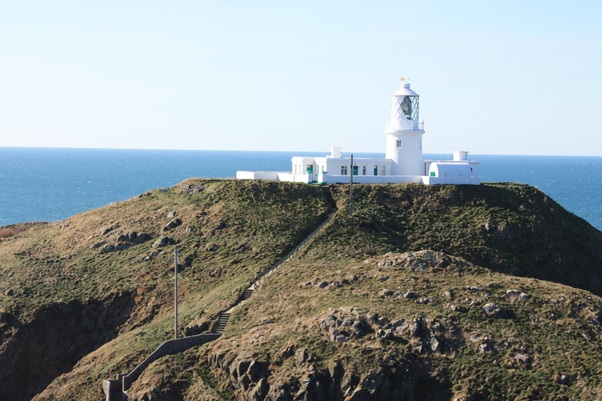Goleudy Pen Strwmbwl | Strumble Head Lighthouse

Goleudy Pen Strwmbwl | Strumble Head Lighthouse
Saif 45 metr uwchben y llanw gyda thwr 17 metr o uchder. Mae gan y golau ystod o 26 milltir forol. Ceir trefn wahanol i fflachiadau pob goleudy fel bod morwyr yn gallu adnabod pob un yn syth, hyd yn oed mewn tywydd mawr. Mae trefn fflachiadau Strwmbwl yn 15 eiliad o hyd ac yn cynnwys pedair fflach dwy eiliad ac yna 7 eiliad o dywyllwch. Os bydd pŵer trydan yn cael ei dorri, bydd generadur yn gweithio yn awtomatig ac os bydd hwnnw’n methu mae banc o fatris pŵer uchel a fydd yn gweithredu fel goleuadau argyfwng.
Roedd y system lens cylchdroi wreiddiol yn pwyso 4.5 tunnell ac fe’i daliwyd mewn bath o arian byw i leihau ffrithiant. Roedd system clocwaith yn gyrru’r golau. Byddai pwysau chwarter tunnell yn hongian ar gebl a oedd yn cael ei ollwng, pob yn dipyn, i lawr silindr o ben y twr i’r gwaelod. Roedd yn rhaid ei weindio bob 12 awr. Pan drydaneiddiwyd y goleudy ym 1965 disodlwyd y system optegol gwreiddiol gan offer mwy modern.
Mae plac pres ar wal ystafell y llusernau yn dyfynnu geiriau o Salm 127: ‘Os yr Arglwydd nid adeilada’r tŷ, ofer y llafuria ei adeiladwyr wrtho . Os yr Arglwydd ni cheidw y ddinas, ofer y gwylia y ceidwad.’
Ar y tir mawr gallwch weld olion y winsh a ddefnyddiwyd i drosglwyddo nwyddau i’r goleudy. Roedd hyn cyn adeiladu’r bont alwminiwm bresennol, 24m o hyd. Disodlidd hon y bont haearn wreiddiol ym 1963. Mae reilen law yn arwain o ben y grisiau ar y tir sy’n rhedeg wrth ochr y bont ac i fyny i’r goleudy. Dyma y beipen wreiddiol lle roedd olew yn cael ei bwmpio i fyny i’r orsaf. Archwilir y goleudy yn flynyddol gan staff Trinity House. Nodir yn yr hen lyfr cofnodion eu bod yn arfer cyrraedd ar y trên i Neyland ac yna dod gyda cheffyl a thrap i’r goleudy. Y dyddiau hyn, maent yn cyrraedd mewn hofrennydd sy’n glanio ar yr ‘helipad’ ar yr ynys.
Wedi’i awtomeiddio ym 1980 nid oes angen staffio’r orsaf mwyach ond mae staff lleol yn ymweld â hi yn rheolaidd. Yr un cyntaf oedd y Capten David Hughes a oedd yn beilot porthladd Harbwr Abergwaun ac a wasanaethodd fel capten cwch achub yr RNLI yn gynnar yn y 1980au. Trosglwyddodd ef i Geoffrey Badland ym 1991. Mae Mr Badland yn swyddog Tollau Tramor a Chartref wedi ymddeol. Y cynorthwyydd yw Hugh Morgan.
Yn Ionawr 2008, i nodi ei ganmlwyddiant, cynhaliwyd gwasanaeth arbennig yn y goleudy a weinyddwyd gan y Parch Brian Barnes. Ymhlith y rhai a oedd yn bresennol roedd George Bateman a gyflawnodd swydd postmon i’r goleudy dros nifer o flynyddoedd.
Strumble Head lighthouse stands imposingly on Ynys Meicel a rocky island off the Pencaer peninsula which is connected to the mainland by a footbridge. Built in 1908 to ensure the safe passage of shipping in the Irish sea the lighthouse is situated 3 miles east of the port of Fishguard.
The lighthouse is 45 metres above high water with a tower of 17 metres and the light has a range of 26 nautical miles. Every lighthouse has a different flash sequence so that mariners would be able to know where they were. Strumble Head’s is 15 seconds long which comprises of 4 x 2 second flash followed by 7 seconds of darkness. In the event of a power cut a generator automatically cuts in and should that fail there is a bank of high powered batteries which will act as the emergency lighting.
The original revolving lens system weighed 4.5tons and was supported in a bath of mercury to reduce friction. A clockwork system supported it, driven by a quarter ton weight which was suspended on a cable that dropped gradually down a cylinder running from the top of the tower to the bottom and had to be wound every 12 hours. When the lighthouse was electrified in 1965 the optical system was replaced by more compact equipment.
A brass plaque is on the wall of the lantern room quotes words from Psalm 127: ‘Except the Lord that builds the house they labour in vain that builds it. Except the Lord keep the city. The Watchman taketh but in vain’.
On the mainland you can see the remains of the jackstay winch which was used to transfer goods to the lighthouse before the present 24m long aluminium bridge replaced the original iron bridge in 1963. There is a handrail leading from the top of the steps on the land side that runs alongside the bridge and goes up to the lighthouse which is how oil used to be pumped up to the station.
The lighthouse is inspected annually by the Trinity House Elder Brethren and it is noted in the order book that they used to arrive via rail to Neyland and then come by horse & cart to the lighthouse. Nowadays arrival is via helicopter which lands on the helipad on the island.
Automated in 1980 there is no longer a need for the station to be manned but it is visited on a regular basis by the attendant. The first one was Capt. David Hughes who was the Fishguard Harbour port pilot and served as the Fishguard RNLI coxswain in the early 1980’s. He handed over to Geoffrey Badland in 1991 a retired Customs & Excise officer. The relief attendant throughout has been Hugh Morgan.
On January 2008 to mark its centenary a rededication service was held at the lighthouse officiated by Rev Brian Barnes. Amongst those present was George Bateman who delivered the post to the keepers over many years.
